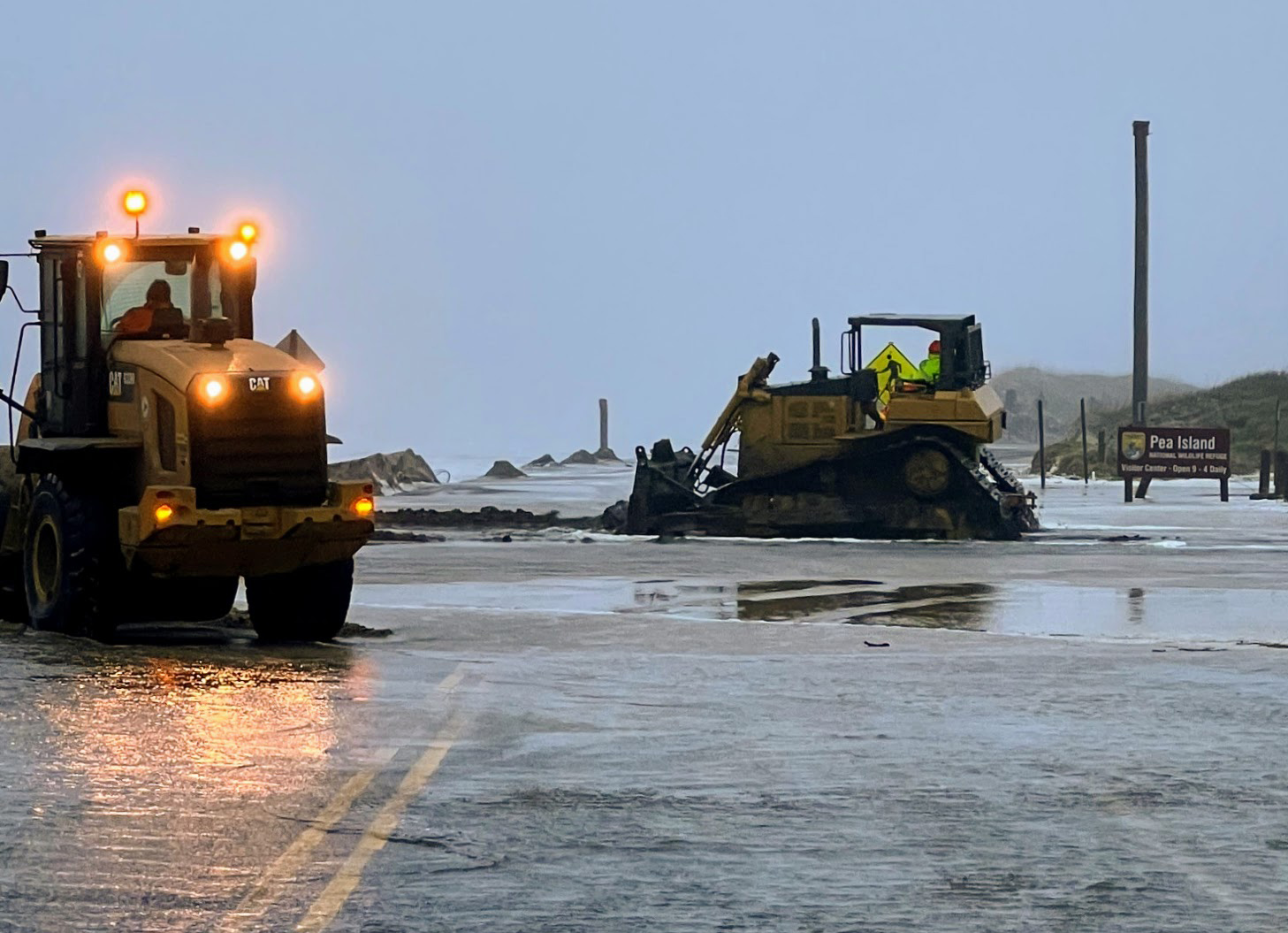By IRENE NOLAN
By IRENE NOLAN
By IRENE NOLAN
Two visitors to the Outer Banks, a man and a woman in their 40s, died while swimming in the ocean in two separate incidents on Wednesday, June 20.
Rip currents were implicated in both incidents.
The first death occurred about 2 p.m. in Nags Head, south of Limulus Street, near the 10000 block of South Old Oregon Inlet Road (near Mile Post 20).
According to a town media release, a Nags Head Ocean Rescue lifeguard stationed in the area responded to cries for help and brought Greg Balsley, 49, of Staunton, Va., and another member of his group, Justin Thomas, 21, to shore.
Upon reaching the beach, the victims received lifesaving measures by emergency services personnel. Both men were then transported to The Outer Banks Hospital by Dare County Emergency Medical Services, where Balsley was declared dead. Thomas is expected to recover fully.
A rip current was present in the area at the time of the tragedy. However, it has not yet been determined whether drowning was the primary cause of Mr. Balsley’s death.
This incident occurred 48 hours after a period of rough weather and surf, during which red, no swimming flags were posted on area beaches.
The second person died, apparently of drowning, on the Cape Hatteras National Seashore.
That incident was reported around 4:15 p.m., according to National Park Service chief law enforcement ranger Paul Stevens.
Two couples were swimming in the ocean south of Nags Head – on Bodie Island near Ramp 4 – when they were caught in a rip current.
Sandra Gassby, 46, of Diamondhead, Miss, died in that incident.
According to the Park Service, her husband, Jeff, was able to swim with her to shore, but he was unable to keep her head above water.
CPR was started immediately, but Gassby could not be revived.
In addition to the National Park Service, Dare County Emergency Service responded to the incident.
According to the rip current threat report from the National Weather Service in Newport, N.C., there was a moderate chance of rip currents on the northern Outer Banks yesterday.
Rip currents are powerful, channeled currents of water flowing away from shore. They typically extend from the shoreline, through the surf zone, and past the line of breaking waves. Rip currents can occur at any beach with breaking waves.
Rip currents are responsible for most drowning deaths on the seashore and the Outer Banks.
If you are caught in a rip current, the NWS advises that you should:
Two visitors to the Outer Banks, a man and a woman in their 40s, died while swimming in the ocean in two separate incidents on Wednesday, June 20.
Rip currents were implicated in both incidents.
The first death occurred about 2 p.m. in Nags Head, south of Limulus Street, near the 10000 block of South Old Oregon Inlet Road (near Mile Post 20).
According to a town media release, a Nags Head Ocean Rescue lifeguard stationed in the area responded to cries for help and brought Greg Balsley, 49, of Staunton, Va., and another member of his group, Justin Thomas, 21, to shore.
Upon reaching the beach, the victims received lifesaving measures by emergency services personnel. Both men were then transported to The Outer Banks Hospital by Dare County Emergency Medical Services, where Balsley was declared dead. Thomas is expected to recover fully.
A rip current was present in the area at the time of the tragedy. However, it has not yet been determined whether drowning was the primary cause of Mr. Balsley’s death.
This incident occurred 48 hours after a period of rough weather and surf, during which red, no swimming flags were posted on area beaches.
The second person died, apparently of drowning, on the Cape Hatteras National Seashore.
That incident was reported around 4:15 p.m., according to National Park Service chief law enforcement ranger Paul Stevens.
Two couples were swimming in the ocean south of Nags Head – on Bodie Island near Ramp 4 – when they were caught in a rip current.
Sandra Gassby, 46, of Diamondhead, Miss, died in that incident.
According to the Park Service, her husband, Jeff, was able to swim with her to shore, but he was unable to keep her head above water.
CPR was started immediately, but Gassby could not be revived.
In addition to the National Park Service, Dare County Emergency Service responded to the incident.
According to the rip current threat report from the National Weather Service in Newport, N.C., there was a moderate chance of rip currents on the northern Outer Banks yesterday.
Rip currents are powerful, channeled currents of water flowing away from shore. They typically extend from the shoreline, through the surf zone, and past the line of breaking waves. Rip currents can occur at any beach with breaking waves.
Rip currents are responsible for most drowning deaths on the seashore and the Outer Banks.
If you are caught in a rip current, the NWS advises that you should:
Two visitors to the Outer Banks, a man and a woman in their 40s, died while swimming in the ocean in two separate incidents on Wednesday, June 20.
Rip currents were implicated in both incidents.
The first death occurred about 2 p.m. in Nags Head, south of Limulus Street, near the 10000 block of South Old Oregon Inlet Road (near Mile Post 20).
According to a town media release, a Nags Head Ocean Rescue lifeguard stationed in the area responded to cries for help and brought Greg Balsley, 49, of Staunton, Va., and another member of his group, Justin Thomas, 21, to shore.
Upon reaching the beach, the victims received lifesaving measures by emergency services personnel. Both men were then transported to The Outer Banks Hospital by Dare County Emergency Medical Services, where Balsley was declared dead. Thomas is expected to recover fully.
A rip current was present in the area at the time of the tragedy. However, it has not yet been determined whether drowning was the primary cause of Mr. Balsley’s death.
This incident occurred 48 hours after a period of rough weather and surf, during which red, no swimming flags were posted on area beaches.
The second person died, apparently of drowning, on the Cape Hatteras National Seashore.
That incident was reported around 4:15 p.m., according to National Park Service chief law enforcement ranger Paul Stevens.
Two couples were swimming in the ocean south of Nags Head – on Bodie Island near Ramp 4 – when they were caught in a rip current.
Sandra Gassby, 46, of Diamondhead, Miss, died in that incident.
According to the Park Service, her husband, Jeff, was able to swim with her to shore, but he was unable to keep her head above water.
CPR was started immediately, but Gassby could not be revived.
In addition to the National Park Service, Dare County Emergency Service responded to the incident.
According to the rip current threat report from the National Weather Service in Newport, N.C., there was a moderate chance of rip currents on the northern Outer Banks yesterday.
Rip currents are powerful, channeled currents of water flowing away from shore. They typically extend from the shoreline, through the surf zone, and past the line of breaking waves. Rip currents can occur at any beach with breaking waves.
Rip currents are responsible for most drowning deaths on the seashore and the Outer Banks.
If you are caught in a rip current, the NWS advises that you should:
Remain calm to conserve energy and think clearly.
Remain calm to conserve energy and think clearly.
Remain calm to conserve energy and think clearly.
Never fight against the current.
Never fight against the current.
Never fight against the current.
Think of it like a treadmill that cannot be turned off, which you need to step to the side of.
Think of it like a treadmill that cannot be turned off, which you need to step to the side of.
Think of it like a treadmill that cannot be turned off, which you need to step to the side of.
Swim out of the current in a direction following the shoreline. When out of the current, swim at an angle–away from the current–towards shore.
Swim out of the current in a direction following the shoreline. When out of the current, swim at an angle–away from the current–towards shore.
Swim out of the current in a direction following the shoreline. When out of the current, swim at an angle–away from the current–towards shore.
If you are unable to swim out of the rip current, float or calmly tread water. When out of the current, swim towards shore.
If you are unable to swim out of the rip current, float or calmly tread water. When out of the current, swim towards shore.
If you are unable to swim out of the rip current, float or calmly tread water. When out of the current, swim towards shore.
If you are still unable to reach shore, draw attention to yourself by waving your arm and yelling for help.
If you are still unable to reach shore, draw attention to yourself by waving your arm and yelling for help.
If you are still unable to reach shore, draw attention to yourself by waving your arm and yelling for help.
Rip current safety tips include:
Rip current safety tips include:
Rip current safety tips include:
Whenever possible, swim at a lifeguard-protected beach.
Whenever possible, swim at a lifeguard-protected beach.
Whenever possible, swim at a lifeguard-protected beach.
Never swim alone.
Never swim alone.
Never swim alone.
Learn how to swim in the surf. It’s not the same as swimming in a pool or lake.
Learn how to swim in the surf. It’s not the same as swimming in a pool or lake.
Learn how to swim in the surf. It’s not the same as swimming in a pool or lake.
Be cautious at all times, especially when swimming at unguarded beaches. If in doubt, don’t go out.
Be cautious at all times, especially when swimming at unguarded beaches. If in doubt, don’t go out.
Be cautious at all times, especially when swimming at unguarded beaches. If in doubt, don’t go out.
Obey all instructions and orders from lifeguards. Lifeguards are trained to identify potential hazards. Ask a lifeguard about the conditions before entering the water. This is part of their job.
Obey all instructions and orders from lifeguards. Lifeguards are trained to identify potential hazards. Ask a lifeguard about the conditions before entering the water. This is part of their job.
Obey all instructions and orders from lifeguards. Lifeguards are trained to identify potential hazards. Ask a lifeguard about the conditions before entering the water. This is part of their job.
Stay at least 100 feet away from piers and jetties. Permanent rip currents often exist along side these structures.
Stay at least 100 feet away from piers and jetties. Permanent rip currents often exist along side these structures.
Stay at least 100 feet away from piers and jetties. Permanent rip currents often exist along side these structures.
Pay especially close attention to children and elderly when at the beach. Even in shallow water, wave action can cause loss of footing.
Pay especially close attention to children and elderly when at the beach. Even in shallow water, wave action can cause loss of footing.
Pay especially close attention to children and elderly when at the beach. Even in shallow water, wave action can cause loss of footing.
For more information and for the daily rip current hazard report, go to http://www.erh.noaa.gov/mhx/RipHazard.html.
The daily rip current hazard forecast is also on the Front Page of The Island Free Press. Click on the yellow tab on the right at the top of the page.
For more information and for the daily rip current hazard report, go to http://www.erh.noaa.gov/mhx/RipHazard.html.
The daily rip current hazard forecast is also on the Front Page of The Island Free Press. Click on the yellow tab on the right at the top of the page.
For more information and for the daily rip current hazard report, go to http://www.erh.noaa.gov/mhx/RipHazard.html.
The daily rip current hazard forecast is also on the Front Page of The Island Free Press. Click on the yellow tab on the right at the top of the page.
Subject
Name
(required, will not be published)
(required, will not be published)
City :
State :
Your Comments:
May be posted on the Letters to the Editor page at the discretion of the editor.
May be posted on the Letters to the Editor page at the discretion of the editor.
May be posted on the Letters to the Editor page at the discretion of the editor.
May be posted on the Letters to the Editor page at the discretion of the editor.
















